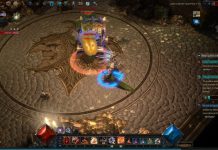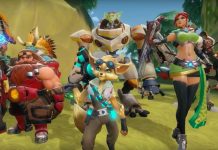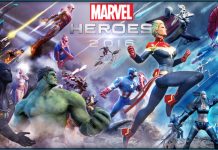Every fantasy land has its problems and when the magical land of Elrios faces grave peril because of the theft of the El Stone, it’s time for adventures to step up and save the people. Developed by KOG Studios, Elsword serves primarily a Japanese audience—and much of the game is centered around an anime-look, with characters who are voiced in Japanese, in the Western market with English localized text bubbles. The version that I played for this review is published by Kill3rCombo.
Elsword is a 2D side-scroller, but it’s described as “2.5 dimensional” because although it’s side scrolling, the environments have a little bit of a sense of depth in that some levels have a foreground and a background region (that you can get your avatar into.) As part of the gameplay involves jumping puzzles or deciding to move up onto a platform, or shift into a different region to get at a bad-guy.
It doesn’t take much to get into the game, in fact it’s a very small download and quick registration. So let’s see what it’s like.
Graphics and Sound: As a 2D brawler, Elsword plays up the arcade look extremely high
Elsword is a brawler at its core and this means 2D scrolling environments and character sprites on top. As a result, much of the screen is dedicated to showing things getting beaten up. A lot of the animations are also focused on splashes of light, falling down, as well as numbers and figures leaping out of the screen when some sort of critical hit happens.
Since characters in Elsword each happen to have their own distinct look (and are characters in a story) this means that the art team works specifically on each one as if they’re cartoon characters and animates them as such. As a result much of the game looks like a playable animé with characters and environments to book. Every character and mob also has animations for getting hit, knocked back, and knocked down. All sprite-based in brawler-type fashion and it can be satisfying watching someone get knocked around or smacked down.
The environments that battles take place in are also very cartoony but fitting to the character look. Sometimes the details in the background of the environment are nicely detailed and filled with depth—but I haven’t once yet been confused too much about a background element being a foreground enemy or objective (which is a good thing.)
Although it’s a 2D brawler, the environments themselves are semi-3D that shifts and moves around the character (and sometimes moves to occlude view) but the developers have done a good job of making it look like that landscape has depth—and in fact it’s possible sometimes to access two different routes (upper and lower) by going along different paths. The result is that it’s a 2D brawling style within a slightly 2.5D world.
Elsword has some light, lilting music that pops up once and a while, but nothing that stuck with me. What does stick out is that the game’s environments do happen to have ambient sound, so bird chirps and other sounds sometimes come through giving a sort of atmospheric sense of locations. Although this is an underused detail, it’s curious how much I noticed it in the game.
Attacks and player actions each have their own sounds, but they repeat a lot—this is a brawler after all so you’ll be hearing people call out attacks and the same sort of smacks and explosions quite often. However, since most of my attention was spent on hitting the keyboard keys, moving around, and beating people in the face (with my drones) this meant that the sounds themselves became queues for “things happening” and didn’t strike me as that repetitious.
The sounds in the game have an arcade sense of clarity and sound quality so there’s nothing out of the ordinary there.
Gameplay: Keyboard-mostly makes a brawler feel like playing a console game
The game doesn’t so much have character classes as named characters who fall into particular roles and have abilities—as a result, players will find themselves with a specific “look.” This is common for many 2D games and is extremely exemplared in Rusty Hearts from Perfect World Entertainment.
Elsword, the eponymous character, is a swordsman/melee character who hacks and slashes he way through swords. Aisha, a mage who uses magic and distance attacks to wipe out large groups of enemies or deliver massive single target damage. Rena, an elf who joins up in the search for missing El, she’s a bow-weilding ranger who spends a lot of time at range but has some nice up-close strikes as well. Raven is an odd medium and short range fighter who uses a claw. Eve, the last surviving member of a robot race, fights with floating drones that give her ranged and melee combat as well as a strange variety of confrontational powers that use point-blank-AoE as well as explosive dodges and team buffs. The list continues as Elsword adds more characters to the mix.
As a result of player-as-character, there’s very little customization that is done at start up. In fact: none. Players instead use costuming items bought from the virtual item store in order to distinguish their characters, and like many MMORPG games, equipment picked up changes appearance as well.
Characters are controlled with the arrow keys, powers activated with the left-hand keyboard (A,S,D,F,Z,X,C) and consumables are triggered with number keys (1,2,3,etc.) As this is a 2D side-scroller, the mouse is eschewed entirely for combat and motion; however, it can be used for menus such as equipping, buying, trading, etc. As a result, this game is primarily keyboard based and works primarily as a 2D brawler.
Fighting takes place via a combo system—each character has two types of attacks generally split between strong/light or melee/ranged under X and Z. Tapping these buttons in a certain order with arrow keys triggers different types of attacks, A,S,D,F,etc.
Freemium: As a free-to-play game expect some costumes and boosts in the virtual item store
As a free-to-play game Elsword goes the freemium route with a freemium currency and a in-game virtual item store. Looking over the store shows that it contains most of the same sorts of items that you expect anywhere: aesthetic costume items, quality-of-life services such as XP boosts and the like for cash-heavy time-strapped players. However, there’s a great deal of elements that permit players to buy items that have real play value (such as accessories) while many of these appear to be available for in-game cash, this might be seen as problematic by players.
The freemium currency is known as k-Ching.
Also, the cash shop contains sets for crafting, enabling characters to make better equipment with the freemium currency. As with other games of this type, that use crafting, there’s the ability to buy crafting items and enhancement items from the cash shop that have a chance to break—this means that sometimes people might pay money for something in the cash shop, attempt an enhancement, and end up losing the item anyway. This sort of gamble is often frowned upon by players.
Costume items also use a time-limited feature where players pay for 30 days of a particular costume. For example, an “Eve’s Yukata Hair” can be bought for a month for 300k-Ching; but for double that at 600k-Ching it will last permanently. Most people who buy items don’t want to get it just for a short period (and only double-the-price seems like a better call.)
Conclusion: Elsword doesn’t stand out that much as a 2D brawler game, but has room to grow
The 2D side-scrolling brawler market is already full of games such as Maple Story and WonderKing (not to mention Rusty Hearts) so there’s a definite genericization that’s going on for games of this style. Much of it appears to be a segregation for audiences from Japanese, Chinese, or even Korean developers working their angle to pull in players. When it comes to this, it’s obvious that the anime and generic brawler elements of Elsword are designed to fit cleanly into the market.
The game is also constantly updating what players can get into in later levels and spends time trying to make each of the characters look and feel interesting. To do this it involves costuming and other elements that make it about getting players to buy from the cash shop.
There’s a large community already there and I cannot go to a single town-channel without seeing people hanging about. In fact, guilds are so prevalent that new characters I make get invitations quickly (although few people talk in them after joining.)
Someone who plays Elsword casually looking for a everyday brawler that doesn’t cut corners but also doesn’t really push the envelope will find everything they want here. Even daily missions, things to beat up, and a story to follow. The game is constantly evolving and adding more end game content, so it’s likely that it’ll provide hours of enjoyment through many months to come.



















